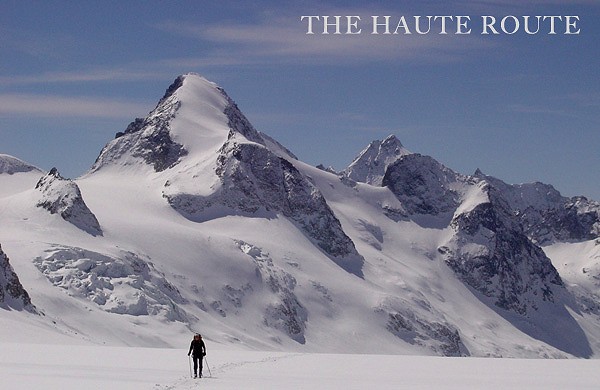
It was freezing in the Vignette hut. I was gradually thawing myself out with a hot chocolate after a bitterly cold day on the Otemma glacier when a friendly American ski mountaineer struck up a conversation with us. I've forgotten his name, but it might have been Troy. He asked where we had come from, so presuming that he didn't really care that we'd come from the Chanrion hut, we replied that we'd come from Scotland. I was expecting him to say he had a load of relatives in Scotland. Funnily enough he didn't say that. Instead he told us about another team from Scotland attempting the Haute Route who were a few days behind us. He added that he was not surprised that they'd baled out after a few days because they didn't have enough experience. Almost as an afterthought, he added, “After all, they had only done about ten days ski mountaineering experience each”.
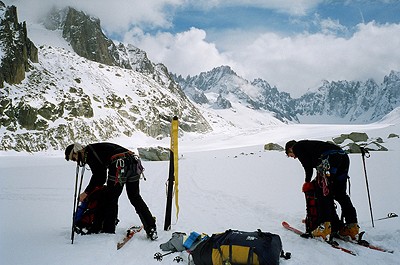
Silent communication flickered between me and my mates Rob and James. We said nothing, not really needing to look, just a small glance at each other. He continued, incorrectly suggesting that for us to be one day away from Zermatt and with a successful traverse of the Haute Route within our grasp, we must have more than the paltry ten days each. Again we said nothing. A pattern was emerging by now - he would say something, we would avoid answering, so he would speak again. Filling the silence he asked us how much touring we'd done. “Well..er...”, I shuffled about uncomfortably on the seat, “I've done a few days in Scotland and the Alps...Rob here did a day in the Cairngorms a year ago...and James here, well, his first day touring with skins was four days ago”. To this day I can't work out who was more surprised; our friendly American hearing that despite our relative inexperience we were a day away from finishing the Haute Route, or us a day later in Zermatt, realising that somehow we had actually done it.
The truth of course is that we were lucky, and we knew it. I have met ski mountaineers who have tried it a few times, but been storm-bound in huts and forced to abandon it. Folk arrive in Chamonix well prepared to do it but are faced with the wrong conditions, so end up going home earlier than planned. But I can't help thinking that you can make your own luck by reducing the odds against you, at least to a point. I had been on the Haute Route back in 1991 on my first trip to the Alps as a summer glacier tour, so knew the Swiss part of it. Between us we had seasons of Alpine and Scottish winter experience, and Rob and James (unlike me) could cope with any off piste skiing. We had a reasonable chance.
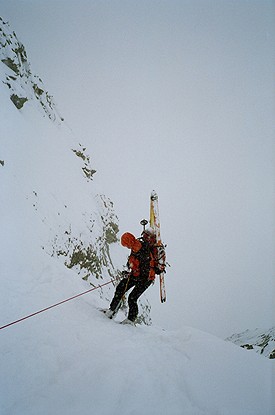
So I hope to dispel a myth about attempting a ski tour like the Haute Route. It has a substantial reputation, but this should not put you off. The American guy had a point, that more ski mountaineering experience would be preferable; but cumulative alpine experience and thorough preparation can compensate. Hours spent reading the route description, re-reading books about avalanches, practising transceiver searches and crevasse rescue were not wasted hours; they loaded the dice in our favour and gave us the confidence to try it on our own without a guide. If conditions are good and the weather reasonably favourable (by which I mean good and favourable enough by your standards of experience and how much discomfort you are prepared to put up with), it is within the grasp of a competent team of alpinists who can ski. Thousands of alpinists who ski would quite happily go over exactly the same route as a walking tour; doing it on skis is not particularly different.
That's not to say it was a doddle. Of course it was difficult and challenging at times, but so are loads of routes that loads of climbers do. As the “differently-able” skier in the team, I knew I would struggle with some of the descents, and I definitely did struggle at times. On skis I resemble a newly-born giraffe at the best of times. At the top of the long descent from the Col du Sonadon I spent more time lying face-down in the snow than floating over it, getting up again only to wipe out again and again. But after a few days, even a poor skier like me could not fail get at least slightly better at it. In a good team each brings particular strengths; Rob had less winter mountaineering time under his belt, so didn't care much for the delicate icy traverses on crampons. He couldn't comprehend how I'd happily crampon across exposed slopes but not sideslip on skis down steep icy stretches, opting to take off my skis and descend with axe and crampons instead.
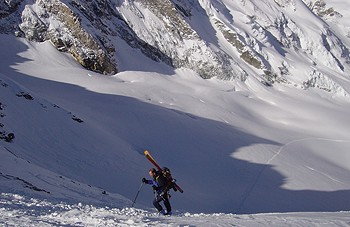
If there was a long ascent on skins, Rob would take the lead. James would link effortless telemark turns on steep descents to go ahead of me and Rob. As long as the team collectively has the experience and no one individual is the dunce at all the disciplines, then it is reasonable to expect the team to do well overall. I would be wary of trying this with total strangers, but I'd been in some tight situations with Rob and James before and figured we would get through it even if we had a good old mountain epic on our hands.
Nevertheless I found myself feeling distinctly uncomfortable about it all on the cable car up to the Grand Montets Col. Nagging thoughts spun in my head. Would I cope with the off piste skiing? Would we be stormbound in a hut in the middle of nowhere for days? Was I fit enough? Should we have done more acclimatisation? As I looked round the cablecar at other parties setting off on the Haute Route, I realised that I had taken the time-honoured British approach of taking too much kit with me. Skiing off piste down from the Grand Montets Col with too much kit in my rucsac was a brutal introduction to what was ahead. I simply couldn't get used to the altered centre of gravity and found myself immediately on harder off piste terrain than I had previously experienced, but somehow I ended up unscathed on the Argentière glacier.
There is a lesson here, one we all hear but often ignore – go light. You know what technical gear you will need (and it isn't much), and how much clothing you need to look after yourself in the Alps. So once you've packed that, if you are unsure if you should take a particular piece of clothing or equipment, then the chances are you should leave it behind. Don't even think about taking a technical axe as your only tool – it will spend virtually all the time on your rucsac anyway. Borrow a mate's lightweight axe instead. I feel qualified to say this because I took too much clothing and a heavy technical axe!
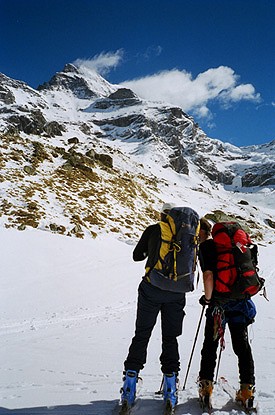
We took our time to get to the Argentière hut, savouring the view and adjusting to skinning along. We had considered going for the Trient hut in one long push from Grand Montets, but I would advise taking the first day easy to get used to it, and then get a good night's rest at altitude before the long climb up to the Col Chardonnet. Why put yourself under unnecessary pressure so early on?
Like most mountain cols, the Col Chardonnet looked relatively close but never seemed to get any closer. The skin up from the Argentière glacier was hard work, as my ropey technique worked against me and as our lungs worked overtime at altitude. By the time we reached the col we were practically in a white out. We could have been anywhere really; abseiling down an Alpine gully in a white out is exactly the same as abseiling down a Scottish gully. It's no worse in the Alps than anywhere else. Again, no need to be put off trying.
A compass bearing lead us to the atmospheric Col de Saleina. It is a small col with imposing towers or rock peering down at us through the mist. We could glimpse the Trient hut occasionally through the clouds. Again we had the same illusion, it looked ten minutes away but took over an hour. Other teams of ski mountaineers appeared out of the gloomy half-light from different directions, silently skinning along. Our paths converged as we approached the final climb to the hut. No one said anything, no one needed to; a silent expression of mountain camaraderie. After several hours of skiing over fresh damp snow, the glue on my skins finally gave up on me and the last 100 metres to the hut were sheer purgatory. I waded through thigh deep snow. I felt pretty ill that evening in the Trient hut, tired and depleted. Fortunately the third day is almost completely down hill.
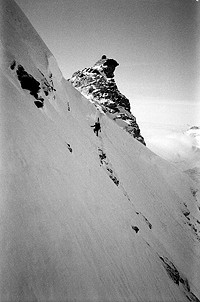
The next morning we attempted to ski roped up to avoid crevasses. We realised very early on that the best way to avoid crevasses was to look ahead and avoid them rather than skiing in a clumsy roped up team where you concentrate so hard on staying up that you do not concentrate on picking a safe line. Perhaps we should have practised this before we set off on the Haute Route! The rope went back in the rucsac and we wound our way to the steep descent along the side of the Trient glacier. Looking back now, I'm not really sure why we did this; there was nothing wrong with the visibility. We misjudged the situation, so wasted time, but learnt the lesson from it.
James and Rob confidently sideslipped down a very steep icy slope with yawning crevasses to the side; I opted to crampon down it. A short steep ascent took us to the Col de Saleina above Champex. The long run to Champex descends over 1900m, initially with a steep descent, followed by a long gentle shuss then some fun skiing in the woodline to join a pisted run. After a slog of a day before, this day comes as an exhilarating rest day with the prospect of a large meal in a restaurant to keep you going. Bearded and smelly, we walked into the nearest restaurant and pigged out on rosti and beer. With three days down and four to go, it seemed achievable by now.
After an overnight stay in Bourg St Pierre and a much needed shower, the day to the Valsorey hut is a day of contrast. The valley heading east from Bourg St Pierre does not catch the sun early on in the day, so for a few hours the route consists of a gentle walk on frozen ground up towards the snow line. You enter a shady gorge then emerge into the boiling sun where it is time to put on the skins. The view is incredible; Mont Velan dominates on the right, with fresh tracks in deep powder from cols high up giving you something to take your mind off the uphill slog to the hut. Emerging around a corner the view to the Grand Combin is breathtaking, and tracks can be seen on the traverse to the Plateau du Couloir. It does look intimidating, but that's partly because it's so high above you at this stage. When viewed from the Valsorey, it looks less intimidating. Don't be put off; it is exposed but if you are considering the Haute Route, I'm sure you have cramponed across steeper or more exposed slopes elsewhere. It's like the Eastern traverse on Tower Ridge, not the Hinterstoisser Traverse on the Eiger.
The guardian in the Valsorey mentioned that there was a French pair of tourers who were attempting to go from Chamonix to Zermatt in under twenty-four hours. A support team was in the Valsorey, waiting to hand axes and crampons over to them for the next day. Shortly after setting off from the hut the next morning, we saw two figures several hundred metres below the hut. They were clearly fast, but we figured we would get to the plateau before them. Despite a headstart of four hundred vertical metres, we were wrong. They burnt past us on the exposed final traverse and disappeared off down towards Chanrion. The were using the super lightweight approach, and were efficient in all that they did; whereas we could happily while away twenty minutes changing from crampons to skis, they took a minute and just disappeared. We never saw them again.
I have already mentioned the heavy porridge conditions so I will not dwell on them again. We wound our way past the icefalls then schussed gently towards the wide ledge that leads round the snout of the ridge. I had been here fourteen years ago and could see how much the icefall had receded due to global warming. Skins came on again for the traverse, then off again for a great descent to the river bed, then on again for the final climb to the Chanrion hut. The descent from the top col had gone on for about seven kilometres. In the hut that night we heard the French speed merchants took twenty minutes to do this. I was probably still faffing around with my bindings by the time they had finished!
We opted for the easier option of skinning up the Otemma glacier to get to the Vignette hut rather than going over the Brenay. There's probably only an hour's difference, but we felt like taking it easy for the day. As you curl left and up towards the Vignette hut, there is a steep concave bowl at the head of the Vuibé glacier. I paused there, feeling certain that it would be no place to fall in the morning.
The next morning, I predictably took a tumble and fell down the very same slope. One second I was up on my skis, the next I was windmilling down hill, then the next second I had somehow come to a stop. I had paused for thought at the top of it, contemplating whether to crampon or ski across it. I had taken the idle option of avoiding changing from skis to crampons and back to skis again within the space of fifty metres. I chose poorly and the lesson is so obvious that I don't need to spell it out. With only my pride dented I continued to the Chermontane col.
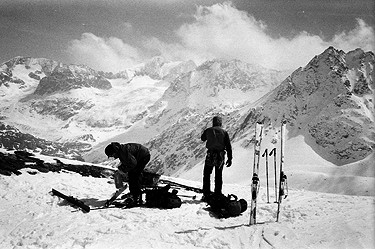
A succession of long climbs lead to a series of cols which give exhilarating down hill runs to the next climb. This is a long day, but one to be savoured. We eventually stood on the Col Valpelline. I was dumbstruck, completely lost for words, laughing with relief. The panorama of the Zermatt 4000ers was breathtaking, and we realised that there was no more ascent between us and Zermatt. In fact, that's an understatement. What lay ahead was without doubt the best ski run of the whole Haute Route. You only need to look at the number of skiers who come up here by helicopter for this run to realise its quality. We expected wet slushy snow but found perfect conditions. A series of terraces lead to a long schuss under the face of the Matterhorn. We found the piste and skied right down into Zermatt, and headed straight for a pint before the train back to Chamonix.
Chamonix had gone mad while we were away. It was the last night of the ski season, and town was full of chalet girls having three-legged races, chalet boys dressed up as chalet girls, everyone drinking hard to delay the inevitable end of season. After so much space high up in the mountains with so few people, it did feel strange being thrown into a town full carnival mode. As we walked through town with skis and rucsacs on our backs, everyone looked at us as if we had just landed from another planet. But clearly we soon got over it and went out for a drink in Goofy's.
We got talking to a group of girls at the bar. One girl in particular intrigued us. I've forgotten her name, so for the sake of the story let's call her Kate. Kate asked us how long we'd been in the Alps, and what we'd been up to. We casually referred to a few days touring here and there, trying to be evasive. The experience in the Vignette hut made us wary, keen to dodge the inevitable. Something was not quite right, but I couldn't put my finger on it. Was she one of the French speed merchants? No, they were both men. The questions came inevitably and quickly, asking us which tour we had done, where we'd been, what snow conditions were like, how crowded the huts were, where we had just come back from. Kate had clearly done a fair amount of touring, it clearly wasn't just idle skiing chat. An idea was forming in my mind, but I still couldn't place it. At first we dodged giving specific answers, but we gave in and mentioned that we'd returned that evening from Zermatt. Immediately she asked “Haute Route yeah?”. “Yes”. What she said next cut us down to size and put us well and truly back in our box: “It's great isn't it? The last time I did it I enjoyed it more than the previous times”.
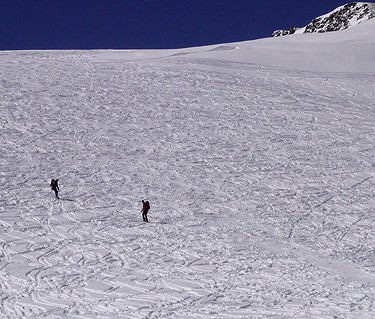

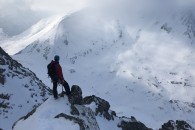

Comments